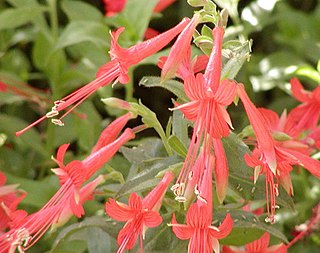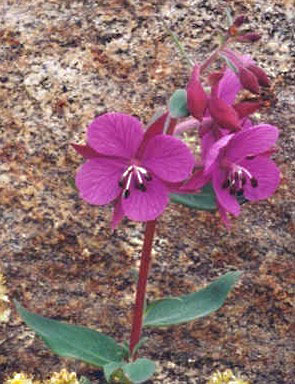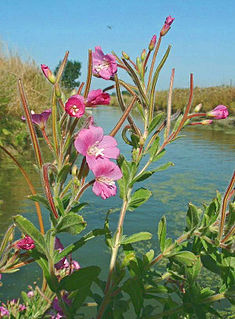
Epilobium canum, also known as California fuchsia or Zauschneria, is a species of willowherb in the evening primrose family (Onagraceae). It is native to dry slopes and in chaparral of western North America, especially California. It is a perennial plant, notable for the profusion of bright scarlet flowers in late summer and autumn.

The Onagraceae are a family of flowering plants known as the willowherb family or evening primrose family. They include about 650 species of herbs, shrubs, and trees in 17 genera. The family is widespread, occurring on every continent from boreal to tropical regions.

Epilobium is a genus of flowering plants in the family Onagraceae, containing about 197 species. The genus has a worldwide distribution. It is most prevalent in the subarctic, temperate and subantarctic regions, whereas in the subtropics and tropics Epilobium species are restricted to the cool montane biomes, such as the New Guinea Highlands.

Chamaenerion is a genus of flowering plants in the family Onagraceae. It has sometimes been included in the genus Epilobium. Members of the genus may be called willowherbs, or fireweeds, based on a common name used for C. angustifolium. They are upright herbaceous perennials, growing from a woody base or from rhizomes, with racemes of usually purple to pink flowers. All species are found in the northern hemisphere. Most occur in moist habitats; C. angustifolium is the exception, favouring disturbed ground.

Epilobium hirsutum is a flowering plant belonging to the willowherb genus Epilobium in the family Onagraceae. It is commonly known as the great willowherb, great hairy willowherb or hairy willowherb. Local names include codlins-and-cream, apple-pie and cherry-pie.

Epilobium anagallidifolium is a species of willowherb known by the common names pimpernel willowherb and alpine willowherb. This small flowering plant has a near-circumboreal distribution and can be found in mountain ranges further south, where grows in alpine climates. It is a perennial found in low clumps rarely exceeding 20 centimeters in height.

Epilobium ciliatum, known by the common names fringed willowherb, American willowherb, slender willow herb, and northern willow herb is a species of flowering plant in the willowherb family Onagraceae. This species is native to much of North America, southern South America, and East Asia. It is an introduced species in much of Eurasia and Australia.

Epilobium glaberrimum is a species of willowherb known by the common name glaucous willowherb. This clumping perennial wildflower is native to western North America from central Canada to northern Mexico. It generally grows at some elevation in moist places. This plant is somewhat variable in appearance. It may exceed half a meter in height and has hairless foliage with leaves between one and 8 centimeters long. The flower has four notched petals in purple, pink, or white which may be only a couple of millimeters long to over a centimeter long each. The fruit is a narrow, sticklike capsule 2 to 7 centimeters long.

Epilobium lactiflorum is a species of willowherb known by the common name milkflower willowherb or whiteflower willowherb. This plant is found throughout northern North America and northern Eurasia, where it most often grows in moist, rocky areas at some elevation. It is a hairy, clumping perennial with thin stems reaching 10 to 50 centimeters in height, and leafy stolons. The leaves are 2 to 5 centimeters long and have hairs along the edges and winged petioles. The tiny flowers are usually white, sometimes pink, and have notched petals 3 to 6 millimeters long. The fruit is a hairy capsule up to 10 centimeters in length.

Epilobium minutum is a species of willowherb known by the common names little willowherb, chaparral willowherb and desert willowherb. It is also called "smallflower willowherb" in reference to its small size relatively. However that name, in particular the British English variant "small-flowered willowherb", typically refers to Epilobium parviflorum.
Epilobium pygmaeum is a species of willowherb known by the common names pygmy willowherb, smooth spike-primrose and smooth boisduvalia. This plant is native to western North America from Baja California to Saskatchewan. It is a resident of vernal pools and mudflats. This is an annual rarely reaching half a meter in height. It is densely foliated in thick green leaves which are hairless lower on the stems and velvety to hairy toward the tips of the branches. The inflorescences at the ends of the stems are dense with small, pointed leaves between which the flowers emerge. Many of the flowers are cleistogamous, meaning they self-pollinate without opening, while others open to reveal four bright pink darkly veined notched petals. The fruit is a small capsule a few millimeters long.

Epilobium septentrionale, with the common names Humboldt County fuchsia and northern willowherb, is a species of willowherb. Like the wildflower zauschneria, this plant was once treated as a member of genus Zauschneria but has more recently been placed with the willowherbs.

Epilobium clavatum is a species of flowering plant in the evening primrose family known by the common names talus willowherb and clavatefruit willowherb. It is native to western North America from Alaska to northern California to Colorado, where it grows in rocky high mountain habitat such as talus. It is a clumping perennial herb forming bristly mounds up to about 20 centimeters high and spreading outward via tough stolons. The oval-shaped leaves are 1 to 3 centimeters long. The inflorescence is an erect raceme of flowers, each with four small pink petals. The fruit is a capsule up to 4 centimeters long.
Epilobium foliosum is a species of flowering plant in the evening primrose family known by the common names leafy willowherb and California willowherb. It is native to parts of western North America from British Columbia through California to Arizona, where it grows in many types of habitat, including disturbed areas.

Epilobium parviflorum, commonly known as the hoary willowherb or smallflower hairy willowherb, is a herbaceous perennial plant of the family Onagraceae.

Epilobium alsinifolium is a species of willowherb known by the common name chickweed willowherb. This small flowering plant can be found in European arctic regions and further south in mountainous regions with an Arctic climate, as well as in Greenland. It is a perennial found in low clumps approximately 10 to 25 centimeters in height. It has wide, rounded basal leaves and narrower leaves further up the stem. It bears purple or pinkish trumpet-shaped flowers, 7 to 12 millimeters in diameter, and the fruit is a capsule two or three centimeters long.
Epilobium brunnescens is a flowering plant belonging to the willowherb genus Epilobium in the family Onagraceae. It is a small, creeping, perennial plant with white or pale pink flowers. It is native to New Zealand and south-east Australia and has been introduced to Northern Europe. Its common names include New Zealand willowherb in Great Britain and Ireland, creeping willowherb in New Zealand and bog willowherb for the Australian subspecies.

Scythris inspersella, the Norfolk owlet, is a moth of the family Scythrididae, first described by the German entomologist Jacob Hübner in 1817. It has a Holarctic distribution.

Epilobium coloratum, known by the common names purpleleaf willowherb and cinnamon willow-herb, is a species of flowering plant in the genus Epilobium of the willowherb family Onagraceae. This species is native to the Midwest and Eastern United States, as well as the Canadian provinces of Ontario, Québec, New Brunswick, Nova Scotia, and Newfoundland. It is also native to the Dominican Republic and Haiti.















